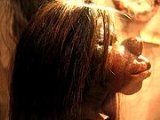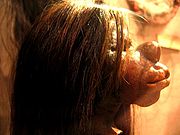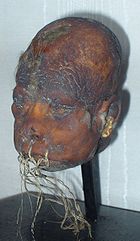
Shrunken head
Encyclopedia

Human head
In human anatomy, the head is the upper portion of the human body. It supports the face and is maintained by the skull, which itself encloses the brain.-Cultural importance:...
that is used for trophy, ritual, or trade purposes.
Headhunting occurred in many regions of the world. But the practice of headshrinking has only ever been recorded in the northwestern region of the Amazon rain forest. In the Amazon rain forest the only tribes known to have shrunken human heads are the Shuar (mainly), Achuar, Huambisa and Aguaruna
Aguaruna
For the Aguaruna people's language, see Aguaruna language.The Aguaruna are an indigenous people of the Peruvian jungle. Historically, they lived primarily on the banks of the Marañón River, a tributary of the Amazon in northern Peru near the border with Ecuador...
, collectively classified as the Jivaroan peoples
Jivaroan peoples
Jivaroan peoples refers to groups of indigenous peoples in the headwaters of the Marañon River, and its tributaries in northern Peru and eastern Ecuador...
of Ecuador
Ecuador
Ecuador , officially the Republic of Ecuador is a representative democratic republic in South America, bordered by Colombia on the north, Peru on the east and south, and by the Pacific Ocean to the west. It is one of only two countries in South America, along with Chile, that do not have a border...
and Peru
Peru
Peru , officially the Republic of Peru , is a country in western South America. It is bordered on the north by Ecuador and Colombia, on the east by Brazil, on the southeast by Bolivia, on the south by Chile, and on the west by the Pacific Ocean....
. Among the Shuar, a shrunken head is known as a tsantsa, also transliterated tzantza.
After World War II, shrunken heads were found at the Buchenwald concentration camp
Buchenwald concentration camp
Buchenwald concentration camp was a German Nazi concentration camp established on the Ettersberg near Weimar, Germany, in July 1937, one of the first and the largest of the concentration camps on German soil.Camp prisoners from all over Europe and Russia—Jews, non-Jewish Poles and Slovenes,...
that were alleged to have been of prisoners. One of them was subsequently presented as evidence at the Nuremberg Trials
Nuremberg Trials
The Nuremberg Trials were a series of military tribunals, held by the victorious Allied forces of World War II, most notable for the prosecution of prominent members of the political, military, and economic leadership of the defeated Nazi Germany....
by U.S. Executive Trial Counsel Thomas J. Dodd
Thomas J. Dodd
Thomas Joseph Dodd was a United States Senator and Representative from Connecticut, He was the first Senator censured by the US Senate since Joseph McCarthy in 1954, and was one of only six people censured by the Senate in the 20th century. He is the father of former U.S. Senator Christopher Dodd...
even though none of the accused was specifically charged with shrinking these heads.
Process
The process of creating a shrunken head begins with removing the skull from the head. An incision is made on the back of the neck and all the skin and flesh is removed from the cranium. Red seeds are placed underneath the eyelids and the eyelids are sewn shut. The mouth is held together with three palm pins. FatFat
Fats consist of a wide group of compounds that are generally soluble in organic solvents and generally insoluble in water. Chemically, fats are triglycerides, triesters of glycerol and any of several fatty acids. Fats may be either solid or liquid at room temperature, depending on their structure...
from the flesh of the head is removed. It is here that a wooden ball is placed in order to keep form. The flesh is then boiled in water that has been steeped with a number of herbs containing tannin
Tannin
A tannin is an astringent, bitter plant polyphenolic compound that binds to and precipitates proteins and various other organic compounds including amino acids and alkaloids.The term tannin refers to the use of...
s. It is then dried with hot rocks and sand, while molding it to retain its human feature. The skin is then rubbed down with charcoal ash. Decorative beads are added to the head.
In the headshrinking tradition, it is believed that coating the skin in ash keeps the muisak, or avenging soul, from seeping out.
Shrunken heads are known for their mandibular prognathism
Prognathism
Prognathism is a term used to describe the positional relationship of the mandible and/or maxilla to the skeletal base where either of the jaws protrudes beyond a predetermined imaginary line in the coronal plane of the skull. In general dentistry, oral and maxillofacial surgery and orthodontics...
, facial distortion and shrinkage of the lateral sides of the forehead; these are artifacts of the shrinking process.
Among the Shuar and Achuar, the reduction of the heads was followed by a series of feasts centered on important rituals.
Significance

Shuar believed in the existence of three fundamental spirits:
- Wakani - innate to humans thus surviving their death.
- Arutam - literally "vision" or "power", protects humans from a violent death.
- Muisak - vengeful spirit, which surfaces when an arutam spirit-carrying person is murdered.
To block the last spirit from using its powers, they decided to sever their enemies' heads and shrink them. The process also served as a way of warning those enemies. Even with these uses, the owner of the trophy did not keep it for long. Many heads were later used in religious ceremonies and feasts that celebrated the victories of the tribe. Accounts vary as to whether the heads would be discarded or stored.
Trade in shrunken heads
At first, cultural restrictions meant that deaths from traditional conflict were relatively rare, and few shrunken heads were prepared. When westerners created an economic demand for shrunken heads, however, there was a sharp increase in the rate of killings in an effort to supply collectors and tourists. The terms headhuntingHeadhunting
Headhunting is the practice of taking a person's head after killing them. Headhunting was practised in historic times in parts of China, India, Nigeria, Nuristan, Bangladesh, Myanmar, Borneo, Indonesia, the Philippines, Taiwan, Japan, Micronesia, Melanesia, New Zealand, and the Amazon Basin, as...
and headhunting parties come from this practice.
Guns were usually what the Shuar acquired in exchange for their shrunken heads, the rate being one gun per head. But weapons were not the only items exchanged
Barter
Barter is a method of exchange by which goods or services are directly exchanged for other goods or services without using a medium of exchange, such as money. It is usually bilateral, but may be multilateral, and usually exists parallel to monetary systems in most developed countries, though to a...
; during the 1930s, when heads were freely exchanged, a person could buy a shrunken head for about twenty-five dollars. A stop was put to this when the Peruvian and Ecuadorian governments worked together to outlaw the traffic in heads.
Also encouraged by this trade, as early as the 1870s people in Colombia
Colombia
Colombia, officially the Republic of Colombia , is a unitary constitutional republic comprising thirty-two departments. The country is located in northwestern South America, bordered to the east by Venezuela and Brazil; to the south by Ecuador and Peru; to the north by the Caribbean Sea; to the...
and Panama
Panama
Panama , officially the Republic of Panama , is the southernmost country of Central America. Situated on the isthmus connecting North and South America, it is bordered by Costa Rica to the northwest, Colombia to the southeast, the Caribbean Sea to the north and the Pacific Ocean to the south. The...
unconnected to the Jívaros began to make counterfeit tsantsas. They used corpses from morgues, or the heads of monkey
Monkey
A monkey is a primate, either an Old World monkey or a New World monkey. There are about 260 known living species of monkey. Many are arboreal, although there are species that live primarily on the ground, such as baboons. Monkeys are generally considered to be intelligent. Unlike apes, monkeys...
s or sloth
Sloth
Sloths are the six species of medium-sized mammals belonging to the families Megalonychidae and Bradypodidae , part of the order Pilosa and therefore related to armadillos and anteaters, which sport a similar set of specialized claws.They are arboreal residents of the jungles of Central and South...
s. Some even used goatskin. Kate Duncan wrote in 2001 that "It has been estimated that about 80 percent of the tsantsas in private and museum hands are fraudulent," including almost all that are female or which include an entire torso rather than just a head.
Thor Heyerdahl
Thor Heyerdahl
Thor Heyerdahl was a Norwegian ethnographer and adventurer with a background in zoology and geography. He became notable for his Kon-Tiki expedition, in which he sailed by raft from South America to the Tuamotu Islands...
recounts in Kon-Tiki
Kon-Tiki
Kon-Tiki was the raft used by Norwegian explorer and writer Thor Heyerdahl in his 1947 expedition across the Pacific Ocean from South America to the Polynesian islands. It was named after the Inca sun god, Viracocha, for whom "Kon-Tiki" was said to be an old name...
(1947) the various problems of getting into the Jívaro (Shuar) area in Ecuador to get balsa wood for his expedition raft. Local people would not guide his team into the jungle for fear of being killed and their heads shrunk.
Since the 1940s, it has been illegal to import shrunken heads into the United States. In 1999, the National Museum of the American Indian
National Museum of the American Indian
The National Museum of the American Indian is a museum operated under the auspices of the Smithsonian Institution that is dedicated to the life, languages, literature, history, and arts of the native Americans of the Western Hemisphere...
repatriated the authentic shrunken heads in its collection to Ecuador. Most other countries have also banned the trade. Currently, replica shrunken heads are manufactured as curios for the tourist
Tourism
Tourism is travel for recreational, leisure or business purposes. The World Tourism Organization defines tourists as people "traveling to and staying in places outside their usual environment for not more than one consecutive year for leisure, business and other purposes".Tourism has become a...
trade. These are made from leather
Leather
Leather is a durable and flexible material created via the tanning of putrescible animal rawhide and skin, primarily cattlehide. It can be produced through different manufacturing processes, ranging from cottage industry to heavy industry.-Forms:...
and animal hides formed to resemble the originals.

